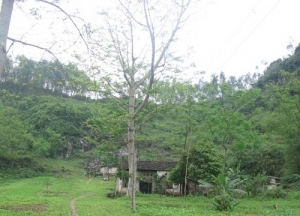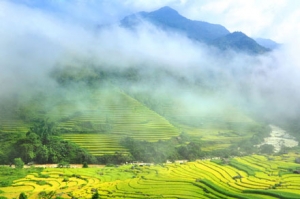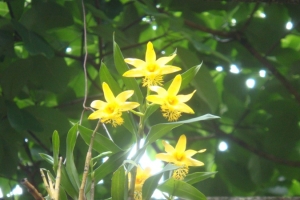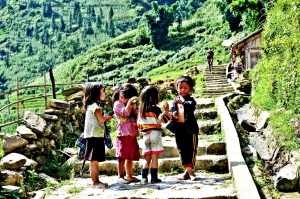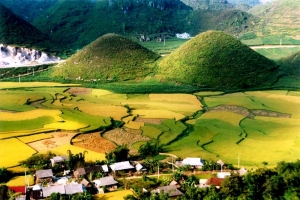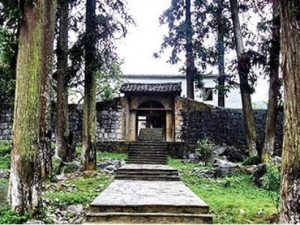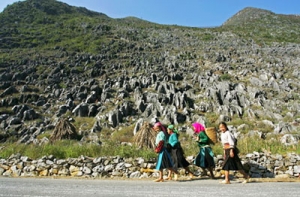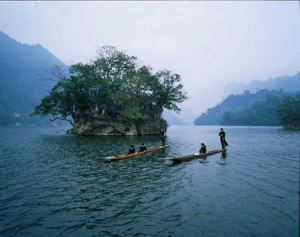
Asia Pacific Travel Team
Tham Mountain – A Beautiful Site in Phu Tho
Tham Mountain, also known as Dau Rong Mountain, is located along the main road to the Thanh Ba industrial zone of Thanh Ba district, Phu Tho province. On the peak of the mountain is a small pond called Ao Tien (Fairy Pond), which is always full of pure blue water. Surrounding Tham Mountain are hundreds of small hills, located one next to another.
A stale plan was established regarding the growth of many industrial plants on these hills, such as tea, lacquer-plants and mu oil trees. Cement, alcohol, and fertilizers are already produced in the area. As well, there are ox and buffalo breeding farms.
Tham Mountain is not only a beautiful site of Phu Tho province, but is an economic centre in the region as well. It attracts many tourists in Vietnam travel coming there to admire its natural beauty.
Watching immense rice terraced fields and exploring unique customs in Cat Cat village of Sapa town
A tribal village of H’mong ethnic people, Cat Cat is located at the foot of Fansipang Mountain, about two kilometers from Sapa Town. It is nestled at the bottom of the Muong Hoa Valley and near the stunning Cat Cat Waterfall. This is an age-old village of H’Mong ethnic people who maintain unique customs and practices from centuries ago.
To visit the village, tourists can walk through Sapa Market and down the valley. Once you disperse from the crowded area, you’ll be stunned by nature’s beauty with high mountains of over 3,000m and the green rice terraces 1,000m below with H’Mong houses scattered in the valley.

Entrance tickets are about VND40,000 before you start to climb the stone steps down to the valley, meeting immense rice terraced fields, bamboo clusters as wells as rice husking mills. On the road, tourists will see many H’mong women with wooden packs on their back and an umbrella. Most H’Mong girls have mobile phones and they can speak a little English.
To Cat Cat, tourists will be guided to visit the brocade weaving craft village to admire a lively and colorful picture with women sitting by looms with colorful pieces of brocade decorated with designs of flowers and birds. When these pieces of brocade are finished, they are dyed and embroidered with beautiful designs. H’Mong women use plants and leaves to dye these brocade fabrics and then they roll a round and smooth section of wood covered with wax on fabrics to polish them, making their colors durable.
In addition to the brocade craft, many residents in Cat Cat are good at manipulating gold and silver jewelry. Their products are fairly sophisticated, especially jewelry for women.
Tourists will be entertained with many folk dances and songs in melodies of panpipes, flutes and lip-lute in harmony with the murmurs of waterfalls, streams and whistles of winds. Tourists are suggested to not miss Tien Sa Waterfall, flowing from Hoang Lien Son Mountain Range. The fall looks splendid like a silver carpet under the glistening sunlight.

Tourists to Cat Cat are most attracted by its unique customs, including the custom of’ ‘pulling a wife’. A man can ask his friends to lure a girl he likes to his house and he keeps her there for three days. During this time if the girl agrees to become his wife, a wedding will be held. However, the girl can happily go home after three days if she does not like him.
The houses of H’Mong people in Cat Cat village have three rooms with three doors and covered with po mu wood roof. Going inside the house there are three columns that stand in round or square stones. The walls are made from sawn timber and the main door is often closed and only opens when people in the house organize important events. The altar, inlaid floor containing food, places for sleeping, kitchen and receiving guests are indispensable parts of the houses.
Tourists visiting Cat Cat Village can discover numerous unique features of H’Mong people.
The beauty of Ham Rong Mountain in Sapa
Ham Rong Mountain, situated in the center of Sapa town, is a impressive tourist attraction. According to Legend, once upon a time there were a couple of dragons so mad in love that while a biblical flood was rising but they didn't know. When they awoke, it was too late for them to escape from the flood so they were washed away separately. Even now, turned into stone, but due to be natural instinct, the female (Ham Rong Mountain) always looks toward her lover in the west (the Hoang Lien Son mountain range).

Shaped like a dragon’s head in the clouds, Ham Rong Mountain is approximately 2000 meters high with green trees and colorful flowers almost all year round. Most tourists in Vietnam travel visiting Sapa do the exciting climb up to the mountain. The path leading up to Ham Rong Mountain consists of many stone steps and a winding trail higher up will help to see small streams lazily run through bushy foliages. About midway, travelers will find themselves in an orchid -garden with over 400 species of colorful blooms. Standing on the highest point of Ham Rong Mountain, tourists will have a breathtaking view over the romantic Sapa town.
If visitors in Vietnam tourism come here in spring, the surprise will be greater to see blooming peach, plum and apricot garden. At midway upwards, there are ethnic cutural villages where visitors will enjoy art-performance by Dao, Mong or Sa Pho young locals.
The sound of bamboo flutes by Mong minority boys echo far and wide, their dances, songs, folksongs sound strong and romantic that will leave unforgettable impressions. A little further more will be a mini stone-forest where thousands of stone columns, pillars that surprisingly open visitors’ eyes.
A stroll among these pillars seems to be a walk in the fairyland, thentourists proceed to the heavens gate, a beaten trail leads to the cloud-yard and a TV station. San May (Cloud Yard) is an ideal location to view the whole panorama of Sapa.
.jpg)

Cat Cat Village - Sapa Vietnam
Cat Cat Village is about 1 km from Sapa town. It's located at the bottom of the Muong Hoa Valley and near the stunning Cat Cat Waterfall. This is an age-old village of H'Mong ethnic group remaining unique customs and practices that are lots in other villages.
To visit village, you walk through Sapa Market down the valley. Once you walk out of the crowd, you'll be stunned by the nature's beauty with high mountains of over 3000 m and the green rice terraces dropping nearly 1000 below. The sun shines across and there are H'Mong houses scattered in the valley
Visitors to Cat Cat have an opportunity to admire a lively and colorful picture. That is the image of young women sitting by looms with colorful pieces of brocade decorated with designs of flowers and birds. When these pieces of brocade are finished, they are dyed and embroidered with beautiful designs. A noteworthy is that H'Mong women use plants and leaves to dye these brocade fabrics. And then they roll a round and smooth section of wood covered with wax on fabrics to polish them, making their colors durable.
In addition to the brocade weaving craft, many residents in Cat Cat are good at manipulating gold and silver jewelry. Their products are fairly sophisticated, especially jewelry for women.
Tourists to Cat Cat are most attracted by its unique customs, including the custom of "pulling wife". A man can ask his friends to lure a girl he likes to his house and keeps her there in three days. During these days, if the girl agrees to become his wife, a wedding will be held. However, the girl can happily go home after three days if she does not like him.
Traditional houses of H'Mong people in Cat Cat have three rooms with three doors and covered with po mu wood roof. In the house there are three columns that stand in round or square stones. The walls are made from sawn timber. The main door is always closed and only opens when people in the house organize important events. Altar, inlaid floor containing food, places for sleeping, kitchen and receiving guests are indispensable parts of the houses.
|
|
|
|
|
|
Visitors to Cat Cat Village can discover countless unique features of H'Mong people.
“The Art of Nature”- Cô Tiên Double Mountain in Quan Ba Ha Giang
As far as 47 kilometers from Ha Giang town, and situated at an altitude of over 1000 meters above sea level, fresh air, wild scenery, majestic nature with endlessly range of Limestone Mountains. The nature has granted here a wonderful place called “Cô Tiên Double Mountain”, it is two tops of the limestone mountain. Its shape is the same as “two breasts” of the girl, lie in the middle of the field in Quan Ba. This actually is an unique landscape of Tam Son in particular and Dong Van stone plateau Geo-park in general.
“Cô Tiên Double Mountain” is truly product of the process of leaching, erosion with regular practice in the destruction of the fault zone in Quan Ba- Huong Cha that its last phase of activity occurred about 5 million years ago. It is the fact that, there are many karst scenes in the valley of Quan Ba, only “Cô Tiên Double Mountain” is the most beautiful and located at the most favorable position to visitors in Vietnam travel can see.
If you are in your tour to the provinces of the Northeast Vietnam, this double mountain should not be skipped when passing Ha Giang province.
The Mansion of Vuong Family Restored to Become a Major Tourism Destination
Located in Sa Phin Valley, Dong Van District, Ha Giang Province, the house originally was the mansion of Vuong Chinh Duc, the head of the Vuong family – the most powerful Mong ethnic family in the region more than 100 years ago. He proclaimed himself as the King of the region, and adopted the title "Vua Meo", meaning "King of the Meo" (former name of the Mong ethnic group) to dominate all the northern mountainous region.
During the Nguyen dynasty, King Khai Dinh in 1913 issued a royal proclaimation appointing Duc as the sole rule of the frontier region; and today visitors can see the royal proclaimation hanging in the main room of the mansion.
Inheriting power from his father, Duc's son, Vuong Chi Sinh, also commanded the region in the early decades of the 20th century before becoming a deputy to the first and second National Assembly of the Democratic Republic of Viet Nam (the forerunner to the Socialist Republic of Viet Nam). He was renamed Vuong Chi Thanh by President Ho Chi Minh
Sinh donated most of his treasure to the Vietnamese resistance government led by President Ho in the war against the French occupation (1946-54).
To enter the 64-room mansion, visitors have to climb up a series of stone steps sandwiched in between old pine trees leading to the mansion's entrance of a small wooden gate set into a round stone wall.
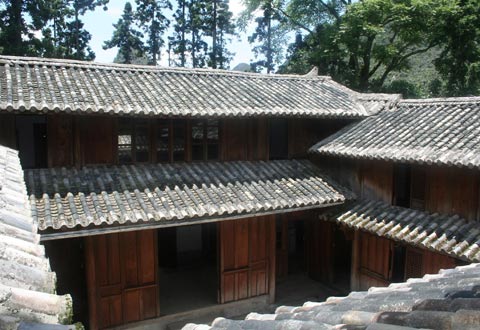
According to Vuong family history, to build the house, Duc invited a Chinese fengshui master to choose an auspicious location for the building. The tortoise-shaped Sa Phin Valley, was believed to act as symbol of longevity and prosperity, a good omen when combined with the protective belt of eight surrounding mountains.
The mansion's structure is based on the shape of the Chinese character "wang", which also means "wealthy", with four horizontal and six vertical house blocks.
Iron wood, green stone and yin-and-yang double tiles are the main materials used in the construction of the mansion, which combines the typical architectural style of the Chinese Qing dynasty with Mong ethnic features. Wealth is also represented through the sophisticated dragon, phoenix and bat patterns carved on the mansion's pillars. The Chinese Han character "shou" meaning longevity also can be seen in every roof tile.
It took eight years to complete the two-storey mansion. Covering 1,200sq.m, the complex includes the main area with living room, working room, bedrooms, and additional rooms for servants and guards, food and weapon storage, a kitchen and cattle stable.
Located in a water-deprived region, the mansion also includes a huge stone tank to retain rain water, which nowadays has become the main water supplier for the valley's residents.
A green area outside the protective wall is the glorious family's graveyard, where visitors can offer incense at the tombs of Sinh and his father. Visitors in Vietnam travel can see the words "tan trung bao quoc, bat thu no le" (A life devoted to the nation, never accepting of being a slave) – the epitaph given by President Ho.
Although recognised as a national architectural and artistic relic in 1993, the mansion was beginning to suffer from a lack of repair and the loss of various valuable household items.
In 2004, a VND7.5-billion (about US$500,000 at that time) project conducted by the Ministry of Culture, Sports and Tourism restored the original beauty of the mansion. The house then become one of the most highlight tourism spots in Ha Giang.
"As an architectural masterpiece of the Mong ethnic people living in the Dong Van karst plateau, the mansion is among one of the must-visit spots whenever tourists visit the region. Local cultural researchers have kept collecting items related to the history of the Vuong family, aiming to turn the mansion into a small museum," said Nguyen Trung Thuong, director of the Ha Giang Culture, Sports and Tourism Department.
Today the mansion not only greets an increasing number of tourists in Vietnam travel, but also welcomes many professional photographers, who are attracted by its unique features and beautiful location.
Vietnam’s first geological park, Dong Van Stone Plateau
Dong Van Rock Plateau is the highland in the most extreme north of Vietnam with majority of the terrain at 1,400-1.600m above sea level and with over 80% of the surface covered by just rocks and with high concentration of rocky peaks of over 2,000m above sea level. The rock of Dong Van is said to contain fossils of 400million-600million years ago.
The park spreads over four districts of Meo Vac, Dong Van, Yen Minh and Quan Ba, with the total areas of over 2,300sq.km, and nearly 250,000 residents living there. Up to 80 percent of the plateau is covered by limestone. The center of the Rock Plateau is Dong Van Town, 150km from the provincial capital town of Ha Giang. The Nho Que River starts its 192km-course from Yun Nan (China) making its flow through the heart of Dong Van Rock Plateau in Dong Van and Meo Vac Districts discharging its water into the Gam River at Bao Lam District of Cao Bang Province. Nho Que brings vital source of water for the whole plateau of Dong Van.
Dong Van Rock Plateau has a temperate climate with average temperatures of 21-23 Degrees Celsius. It may get up to 27-28 Degrees Celsius in July-August and may drop down to below Zero Degree Celsius in January.
Dong Van is home to different 17 ethnic minorities, with diverse cultures and traditions, which make the plateau an interesting destination for tourists in Vietnam tourism. These ethnic minorities live on cultivating rice along the basins of the Nho Que River and corn on the rocky mountain slopes. Life may be tough, but most of the local ethnic groups still stick to their century-old traditions. It is easy for a traveler in Vietnam travel passing by the Rock Plateau to get dumb-founded by watching local people plow in rocks, cultivate crops in rocks, build walls around their home with just rocks.
Joining the network of global geological parks will contribute to attracting tourists in tours to Vietnam, mainly tours to rocky plateau of Dong Van, paving the socio-economic development of the locality.
Followings are some impressive photos of Dong Van rock plateau:
Enigmatic Nam Dan Ancient Rock Field in Ha Giang
About 16 km from the centre of Xin Man district, Ha Giang province, the ancient rock field lies in the middle of a valley in Nung Ma Lu’s hamlet. It is surrounded with terraced fields and milpa of the Nung ethnic people. Here remains a lot of historical relics, such as letters and symbols carved in rocks.
The local people in Nam Dan Commune call this ancient rock area "Na Lai", which means "fields of writing characters". It is a unique vestige with a century-old history which has been ranked as a national vestige. It is also a destination of tourists in Vietnam travel to contemplate the cultural quintessence of the ancient people.
Nam Dan ancient rock field is a large valley which was discovered in 2004, by scientists of the Institute of Archaeology and Ha Giang Province Museum.
In this field, there are many pictures carved into the rocks thousands of years ago. It is different from the vestige of the ancient rock field of Sa Pa in Lao Cai province. This one in Nam Dam is not as famous as the one in Sa Pa, but the beauty and secret of it is none less attractive.
The Nam Dan rock field has many huge rocks with many carved pictures. These rocks are along the Nam Khoong stream. There are about 7 huge blocks and 2 great rocks with over 80 carved pictures and 80 holes.
Archaeologists believe that these pictures and holes have been made by using an iron chisel and hammer. These pictures are of circles, rectangle, square, parallel lines, some symbols (most of them of femininity. There are symbol of triangle and a line in the center), human feet, human in the position of stretching out arms and legs, and some carves which has been still unidentified.
Scientists have showed that this area was possibly a vestige of tomb of a community's leader or a very holy area to worship the gods, ancestors and some great people. In addition, this vestige is also related to the rule of worshipping the god of rock of the ancient people.
If you have a chance to come to Xin Man to go sight-seeing and discover the life of the local people, you should visit this rock field of Nam Dam. There are mountains, streams, big block of rocks, places to relax, and especially in addition to contemplate the wonderful nature…you can also know more about history and the cultural vestige of the old days.
Best time to travel to Bac Kan
During the time from November to February is the cold season in Bac Kan with the temperature is often below 0 degree C, therefore the scenery looks very gray and unattractive.
The hot and wet season runs from April to October with almost all rainy days, so tourists in Vietnam tours won’t have chance to visit outdoor destinations which are some of the most fascinating aspects of Bac Kan such as Ba Be National Park or ATK. It also rains heavily, reaching Bac Kan by buses and other vehicles is more difficult.
The magnificent sceneries in Backan- don't miss!!!
Ba be lake is an ideal destination which has lots of beautiful natural sceneries, delicious foods of ethnic groups. If you have a chance to visit Vietnam Ba be lake is really place can’t miss.
Come to Ba Be lake, beside Dau Dang waterfall, Tien pond, Ba Goa islet… there are very many other tourism sites you should not miss.
1. Ba Be National Park
Tourists in Vietnam travel who come to Ba Be not only enjoy the charisma of nature but also get to know many traditional and scientific values of this natural park through the helpful and energetic tour guides. In sunny days, the scenery resembles a Feng Shui painting that mesmerizes even the most demanding visitors. The surface of the lake is flat; it transforms the whole lake into a mirror that reflects the figures of the majestic mountains and the shining cloud.
Romantically, the young Tay girls in black outfits stand on different boats, helping travelers to cross the picturesque Ba Be Lake. Without a doubt, they are the knowledgeable amateur travel guides who continuously surprise you in your journey to explore this beautiful land. You will be also amazed to learn about the lives of the ethnic groups: their culture, their routine life, their myths, their traditions, etc. People are extremely hospitable in Ba Be so you can even have a chance to visit their house and experience for yourself the breath of Ba Be’s mountains and forests.
2.Nang Tien Grotto (Fairy Grotto)

The grotto is 5 km far from Yen Lac town. Fairy Grotto has appeared naturally for a long time. Legend says that once upon a time there were 7 fairies landing at the foot of Phja Trang Mountain to swim. They enjoyed so much that they did not know that the night came. They could no longer fly back to the heaven. God created a grotto for them to reside. Since then, the grotto has been called "Fairy Grotto". On 13 September 1999, the Ministry of Culture and Information signed decision on recognizing the Grotto as beauty spot at national level.
3. Hua Ma cave

Hua Ma cave is ranked among the most beautiful and interesting caves in the national park, because of its magnificent stalactites and the legend that has been told for generations
The cave has been naturally shaped during the many-thousand-year process of geological changes. It is 700 meters in length and in some places the cave opens up and is 50 meters in height.
The view outside the cave is also great. From the mouth of the cave, people could see a large space, a vast picture of mountains, forests and water. Tourists could see Ba Be Lake and the Nang River running smoothly in distance, could hear birds singing elsewhere and imposing mountains and forest in front.
If lucky enough, tourists could participate in a local monthly market to admire girls and boys of several local ethnic minorities in their traditional colourful costume. Tourists can enjoy local typical specialties and would get drunk with “Can” wine and unconsciously fall in love with the place and people.
4. Pac Ngoi Village

Pac Ngoi Village has more than 40 traditional stilt houses locating on the slope of mountains which surround Ba Be Lake, emphasizing the beauty of this famous eco-tourism destination.
Surprisingly, while the traditional stilt houses have almost been eradicated in many other provinces, the antique, unique and original houses of ethnic groups are still highly valued and preserved in Pac Ngoi despite the presence of modern architecture.
Tourists in Vietnam travel coming to Pac Ngoi are not only entitled to witness with their naked eyes the most wonderful scenery of Northern Vietnam: a plethora of austere yet interesting stilt houses blending themselves with the glimmering mist and the shinning Ba Be Lakes, but also to stay in the rhythm of the Tay culture.
This claim can be easily proven by the fact that visitors joining tours in Vietnam have to remove their shoes once they step the very first steps on the staircase of a stilt house. Inside the house, ethnic people gather around the gleaming fireplace, forgetting themselves in the sophisticate stories about the economy or the politic.
Na Khoang waterfall
With the nice landscape, pure and cool weather and has the value in the geologist and ecologist systems, Na Khoang waterfall has been acknowledged as the provincial landscape.
In the upper part of the waterfall, there is a small lake, which is the ideal location of swimming for those who like to avoid the crowdedness and wallowing in the nature. The surrounding areas are mainly regenerative jungle, which the covering area is from 75 to 85%. In terms of animal, there are many types of bird, reptile, fish and squirrel, etc. People live in there are all from Mong, Dao ethnic groups who are keeping the cultural traditional characters such as the costumes, religion, folk songs, and dancing styles which creates more plentifulness for cultural environment in this place.


